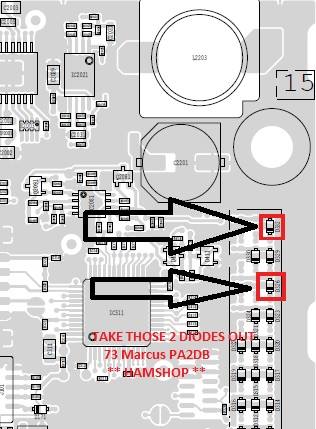The first IC-9700 frequency modification appeared online. Marcus (PA2DB) from HamShop.nl posted this. The modification only works on European models and by removing 2 diodes the frequency can be expanded by a few MHz to the USA market. That means 2 MHz extra from 146-148 MHz (which is a welcome modification for UK users since they have temporarily access to 146-147 MHz) and extension from 440-450 MHz. No wideband or MARS/CAP modification available yet. I guess the diodes can be found in the front.


15 comments
Skip to comment form
I doubt there will ever be an expansion of the RX and TX outside of the bands but I too hope there will be one. I’d like to see cross band repeat too. On the 910 and 9100, you had to solder IN a diode. A bit of a pain but worth it.
Glenn, what makes you doubt this?
I doubt it because Icom (along with those with seemingly more direct knowledge about this) says it will never happen. I would LOVE for everyone to be wrong about that though but the reasoning is to keep the receiver as tight and sensitive as it is, they had to focus only on the Ham bands.
Too bad, but completely understandable. I wonder how the new IC-705 will fare…
Hello, no one did tests that you make various combinations with the diodes to see if you can unlock all the bands? It is incredible with what this equipment costs, they do not allow us to do what we want with it!
Is there any modification to use the IC-9700 on 220MHz band?
Jeśli ktoś wie jak rozblokowac ic 9700 chodzby do 160mhz będę wdzięczny.
Podłączam się do pytania jeśli ktoś wie jak rozblokowac ic -9700 do pasm 160 MHz będę wdzięczny
How nice that would be, For this radio to be the ultimate VHF/UHFand I guess SHF they should have added 220 at high power and also 900MHz then it would have been perfect.
If there was a way to add 220, I would buy a IC9700.
Es gibt (auch technisch) sicher keinen Grund, warum der IC-9700 nicht im TRX-Frequenzbereich von 136-174 MHz und 400-470 MHz erweitert werden könnte – wie viele andere TRX auch!
Dies erweitert den technischen Spielraum (Transverter, Einsatz in anderer Region etc.) erheblich und sollte verantwortungsvollen Funkamateuren nicht vorenthalten werden.
Für mich jedenfalls ein Grund, das Gerät nicht zu erwerben!
Hallo Heinz
Es gibt aus technischer Sicht durchaus Vorteile, wenn das Gerät sich lediglich in den Amateurfunkbändern bewegt. Die Vorfilter können so gewählt werden, dass Ausserbandsignale den Empfänger nicht bzw. weniger desensibilisieren. In der Schweiz arbeitet z.B. der Funkrufdienst auf 147.300 MHz sowie auf weiteren Kanälen in diesem Bereich. Selbst hochwertige Breitbandempfänger werden desensibilisiert, wenn sie in der Nähe eines Funkrufsenders betrieben werden. Der IC-9700 verhält sich diesbezüglich erstaunlich zahm.
Freundliche Grüsse: Christoph / HB9DTZ
Hallo Christoph,
bei meinen Geräten hier im Shack kann ich derartige Nachteile durch die Erweiterungen nicht feststellen!
73 de Heinz
Mir würde ja schon nur RX erweitern.
Und für TX hald gesperrt.
Have you tried to unlock the Japanese version for the 2 m band?